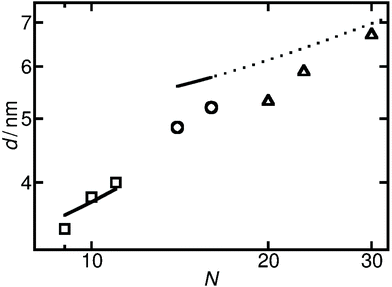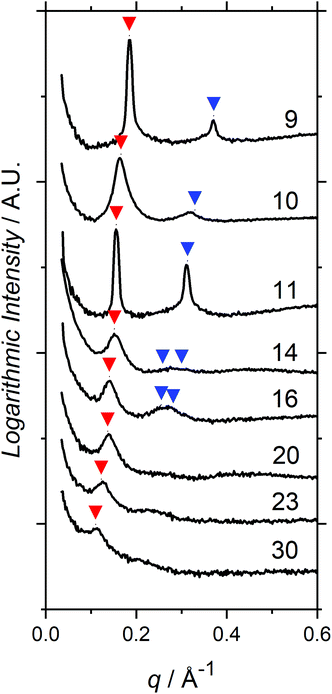 Open Access Article
Open Access ArticleCreative Commons Attribution 3.0 Unported Licence
Correction: Microphase separation of highly amphiphilic, low N polymers by photoinduced copper-mediated polymerization, achieving sub-2 nm domains at half-pitch
Ellis
Hancox
 a,
Evelina
Liarou
a,
Evelina
Liarou
 a,
James S.
Town
a,
James S.
Town
 a,
Glen R.
Jones
a,
Glen R.
Jones
 a,
Siân A.
Layton
b,
Steven
Huband
a,
Siân A.
Layton
b,
Steven
Huband
 c,
Martin J.
Greenall
c,
Martin J.
Greenall
 d,
Paul D.
Topham
d,
Paul D.
Topham
 b and
David M.
Haddleton
b and
David M.
Haddleton
 *a
*a
aDepartment of Chemistry, University of Warwick, Coventry, CV4 7AL, UK. E-mail: d.m.haddleton@warwick.ac.uk
bAston Institute of Materials Research, Aston University, Birmingham, B4 7ET, UK
cDepartment of Physics, University of Warwick, Coventry, CV4 7AL, UK
dDepartment of Mathematics and Physics, University of Lincoln, Brayford Pool, Lincoln, LN6 7TS, UK
First published on 3rd February 2022
Abstract
Correction for ‘Microphase separation of highly amphiphilic, low N polymers by photoinduced copper-mediated polymerization, achieving sub-2 nm domains at half-pitch’ by Ellis Hancox et al., Polym. Chem., 2019, 10, 6254–6259. DOI: 10.1039/c9py01312a.
The authors regret that errors within this work have been discovered while performing further research within this area.
More specifically, F13-PAA9 (N = 14) and F13-PAA11 (N = 16) are described in this paper as weakly ordered lamellae (W/LAM), which must be corrected to hexagonally packed cylinders (HEX). Also, F13-PAA15 (N = 20), F13-PAA18 (N = 23) and F13-PAA25 (N = 30) are described in this paper as weakly ordered hexagonally packed cylinders, which must be corrected to disordered (DIS). Subsequent updates therefore need to be made to the theoretical modelling section of this paper. Previously, a standard strong segregation regime formula and a formula derived for high χ rod-coil block copolymers were used to fit the lamellar phase, which included 5 data points. After the morphology reassignments, 3 LAM data points were insufficient to make a comparison. As such, the LAM phase was refitted to the formula derived for high χ rod-coil block copolymers to determine an adjustable parameter c, which was used in the corresponding formula to predict domain spacings in the HEX phase.
Corrected versions of Fig. 2 and 3 and Table 2 are provided in this notice.
 | ||
Fig. 3 Domain spacing d plotted against degree of polymerisation N. Points in the lamellar phase, in the HEX phase and showing weak microphase separation are marked with squares, circles and triangles respectively. The points in the lamellar phase have been fitted by a formula derived for high χ rod-coil polymers in this phase, and the parameter determined by this fit has been used in the corresponding formula for the HEX phase to predict the domain spacings there. The dotted line shows the domain spacings predicted by the HEX formula at higher N, where the samples show weak microphase separation. For the final five points, the inter-plane spacings reported in Table 2 have been converted to centre-to-centre distances by multiplication by  . . | ||
| Sample | N a | d (nm)b | f PAA | Nanostructure |
|---|---|---|---|---|
| F13-PAA4 | 9 | 3.4 | 0.58 | LAM |
| F13-PAA5 | 10 | 3.8 | 0.63 | LAM |
| F13-PAA6 | 11 | 4.0 | 0.66 | LAM |
| F13-PAA9 | 14 | 4.2 | 0.74 | HEX |
| F13-PAA11 | 16 | 4.5 | 0.77 | HEX |
| F13-PAA15 | 20 | 4.6 | 0.82 | DIS |
| F13-PAA18 | 23 | 5.1 | 0.84 | DIS |
| F13-PAA25 | 30 | 5.8 | 0.88 | DIS |
The following corrections should be made to the body of the text in light of the changes above.
Page 6257, paragraph 1, line 11, the sentence beginning “Polymers where N ≥ 14 show weak intensity” should read “Polymers where N ≥ 11 show weak intensity higher order peaks, indicating a weakly phase separated structure with more ‘liquid-like’ order”.
Page 6257, paragraph 1, line 21, the sentence beginning “At N ≥ 20” should read “At N ≥ 20, the second order reflection is too weak to assign a morphology, as such, these are considered disordered”.
Page 6257, paragraph 2, line 1, the sentence beginning “The extremely short length of the molecules” should read “The short length of the molecules means that standard block copolymer theories,40 which rely on the degree of polymerisation N being large, are unlikely to be appropriate here. To gain insight into these new materials and pave the way for future studies in this area, we have performed some simple theoretical modelling of the dependence of the domain spacing d on N (Fig. 3). To take the shortness of the molecules into account, it is supposed that the F13 block is so short that it should be treated as a rod. Support for this assumption is provided by simulations of PTFE,41 which find that these polymers have a Kuhn length of 2.3 nm, longer than the molecular length of the F13 block itself. The domain spacing in the lamellar phase is therefore fitted with a formula derived42 for high χ rod-coil block copolymers, d = cN2/3fpAA−1/3, where c is an adjustable parameter. We use the values of N listed in Table 2, and have checked that using a definition of N that takes the volume of the repeat unit of one of the blocks as a reference volume (as is often done in fits to domain spacing data43) does not significantly change our results.
Fig. 3 also includes two points in the HEX phase and three where there is evidence of weak microphase separation, but the morphology cannot be identified for certain. To study the HEX points, a formula provided in ref. 42 for the centre-to-centre spacing of the cylinders as a function of N in the HEX phase is used. This formula includes the same adjustable parameter c as the formula for the lamellar spacing and can therefore be used to predict the behaviour in the HEX phase based on the fit to the lamellar data. The prediction of this formula for the numerical values of this spacing is slightly too high. However, when the calculation is continued to higher values of N, it can be seen that the slope of all the final five points is reproduced well by this second formula. This suggests that the three points may retain some hexagonal order, even if this is too weak to be identified in the SAXS experiments. In the case of F13-PAA18, this is in line with the TEM image shown in Fig. 4(b). Note that, for all the final five points, the inter-plane spacings measured in the SAXS experiments and reported in Table 2 have been converted to centre-to-centre distances by multiplication by  .
.
Given that only one free parameter is used, the fit to the lamellar data and the prediction of the slope of the higher-N points is reasonable. However, further investigations are needed to determine what kind of model is appropriate here”.
Page 6258, paragraph 1, line 8, the sentence beginning “The ‘liquid-like’ order” should read “The ‘liquid-like’ order of F13-PAA18 can be seen in the TEM image (Fig. 4b)”.
The authors also regret the incorrect labelling of references 40–43. The correct references are given as ref. 1–4 in this correction notice, respectively.
The authors note that these corrections have no effect on the results reported, nor do these changes/corrections alter the conclusions of the paper.
The Royal Society of Chemistry apologises for these errors and any consequent inconvenience to authors and readers.
References
- F. Bates, Annu. Rev. Phys. Chem, 1990, 41, 525–557 CrossRef CAS PubMed.
- K. M. Salerno and N. Bernstein, J. Chem. Theory Comput., 2018, 14, 2219–2229 CrossRef CAS PubMed.
- M. Müller and M. Schick, Macromolecules, 1996, 29, 8900–8903 CrossRef.
- S. M. Mai, J. P. A. Fairclough, I. W. Hamley, M. W. Matsen, R. C. Denny, B. X. Liao, C. Booth and A. J. Ryan, Macromolecules, 1996, 29, 6212–6221 CrossRef CAS.
| This journal is © The Royal Society of Chemistry 2022 |

